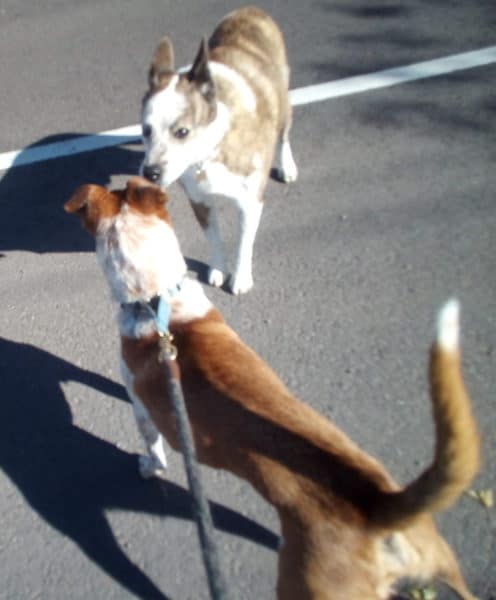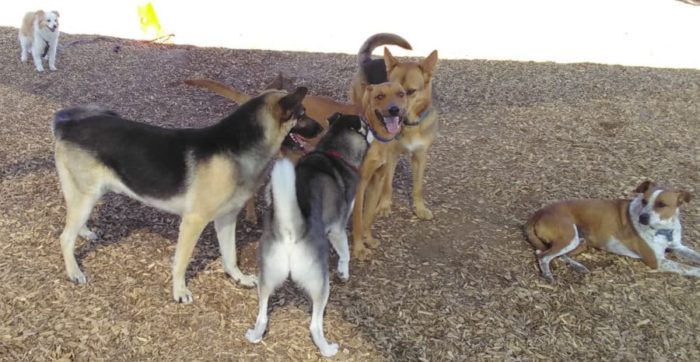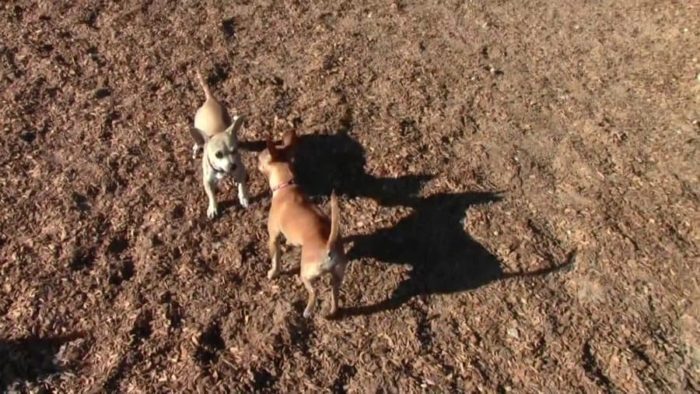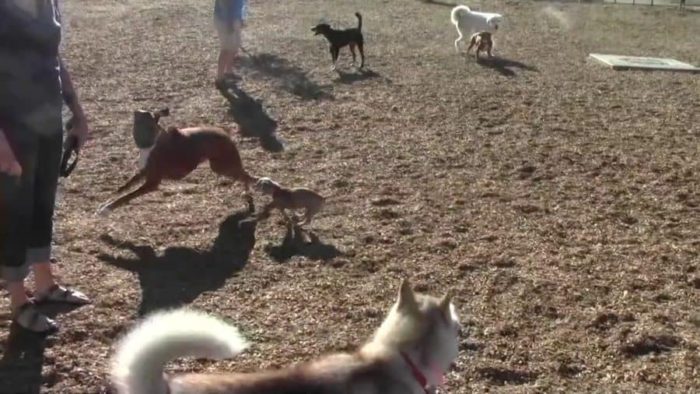With the Nextdoor app’s increasing popularity, I’m seeing more posts with titles such as Dog Safety, Warning, or Attack. The situation is often that somebody was walking their dog when approached by another dog that was either loose or who made it past a gate or fence when seeing them walking. Many of these posts about a loose dog often get about fifty or so responses, with most of them promoting the same approaches. This article reviews the common suggestions and what you might do instead when meeting loose dogs.
A Woman Walking Two Dogs on Leash
In a recent post on Nextdoor, a woman was walking two leashed dogs and was attacked by three large, unleashed dogs, who had just gotten past a gate. It doesn’t appear that any damage was done, and the owners were nearby and quickly pulled their dogs back. Her dogs were scared but not hurt.
Typical Suggestions Offered
Most of the suggestions for the safety of her and her dogs were for her to carry the following:
- Mace
- Pepper spray
- Horn
- Dog mace
- Bear spray
- Wasp spray
- Stick
- Golf club
- Hiking poles
- Stun gun
- Tazer pole
Many people then complained about how it was truly scary that no place here was safe to walk your dog, and that you never knew what was ahead when trying a new route. And other people that they’ve never before lived in any place that was like this. And a dog trainer then offered to teach them to use a taser to protect against dogs.

Then, somebody comes out listing all the do’s and don’ts in managing dogs because it’s worked 20 years for her. She started by telling everybody that people are not at the top of the food chain. That when any strange dog approaches you should become the biggest and baddest one of all, forcefully yelling out imperious commands in your lowest voice, and rapping them on the snout with a walking stick if they don’t listen.
And people then thanked her for all the great advice.

Other Options and Responses for Handling a Loose Dog
Another idea was to shorten the leash and hold your dog tight. However, that keeps him from moving so his panic may turn into terror. You need to control him, but calmly, and the best approach here may be to do some training beforehand. Sadly, most people claim it’s not possible and/or they just don’t seem to care enough to do it.
Yet another idea was to stand your ground and try to appear as large as possible. Then, using the deepest possible voice, yell commands and maybe swing a stick. Now, the dog likely doesn’t know the commands you may yell. And of course, if the dog is already rather nervous, he may then freak out and run, either away or maybe towards your dog.
On that note, I once had somebody lecture me at a dog shelter on always using a low voice because a shrill voice indicates you are showing fear. I then just calmly walked over to a small group of dogs, gave out with the shrillest yell I could, and scared the heck out of them. Did you know that there are predators who give out a high pitched scream (including some small dogs)? That while the pitch does make some difference, that it’s far from the only thing that determines the animal’s response?
How It Looks When People Train Their Dogs for This Situation
That’s perhaps a pretty consistent pattern of responses above. Might part of it be that training your dog to cope with this requires far more time and effort than finding some way to arm yourself with protection? There is certainly nothing wrong with carrying some spray just in case. However, learning and teaching your dog how to handle the situation will prevent many of the problems, as we’ll see next.
A while ago, I was walking down a nearby street when two dogs rounded the corner and rapidly headed towards me. My three dogs simply lined up, and very calmly stood there watching them. The other dogs slowed, stopped, then turned away. If my dogs had been jumping and barking it’s more likely they would have excitedly run over.

Another time, I saw a dog slowly crossing the street towards us. He stopped a few feet away and said hello. He approached and they sniffed for a bit while I snapped a picture. Then he bid a pleasant goodbye and the dog walked back to lay down in front of a house nearby.
In a last example, I saw one of the dog park regulars had a large, loose dog running towards him. He put his dogs behind him and kneeled down to greet this large German Shepherd, using a calm and gentle voice.
Before long he took the dog into the dog park and called the number on his tag. Shortly after, his people pulled up and collected the guy, who was running around and having some fun.

Why Do Things Escalate with a Loose Dog?
Why do most people see this as such a battle? Unless you really look like lunch, most loose dogs will approach just because they are curious about you or your pet. Many of them have few social skills and know only a few commands. Due to this, they may become nervous as they approach. While they often ignore most people, they may be more curious about your dog.
For people who have problems with loose dogs, I often suggest that they really need to first control their own dogs. I’m not adverse to them carrying something that makes them feel more comfortable. However, using something like a horn without their own dogs being prepared and accustomed to it will usually cause them to panic even further. Sure enough, when I read some responses on Nextdoor, some people wrote in that they couldn’t handle the spray because their dogs just couldn’t be controlled.
If your dog is panicking, the other dog will become more nervous. But, they may still have enough interest to approach further. And once they are closer, if your dog continues to panic they may become afraid enough to cause an attack, something that’s often seen with inexperienced new dogs at a dog park or when introducing dogs. Most dogs are not there to be aggressive, but they are just curious and become afraid. Some will then back away, but others may become very reactive.
The Reality with a Loose Dog
When you see a loose dog on the street here, they aren’t really looking for prey. Even the dogs from the reservations that I’ve worked with were no threat. For that matter, the dogs who are ignored in homes are far more likely to be a threat than those who are living outside on their own. This is because they are more afraid of the world.
A dog with good social skills and experience will look to your dog for signals to guide him. If your dog starts to panic he’ll slow down and wait. If your dog doesn’t calm down, he’ll likely just walk away. He won’t be scared because he’s seen this happen dozens of times before, and just gives the other dog a bit of time before trying again.
You’ll see lots of news articles talking about the issues and risks with loose dogs. Some, like this article in a Dallas newspaper, includes what to do by simply stating that you should report the dog the Animal Control. While you should report a loose dog (and ideally get them off the street if you can), there is more you can do.
What You Can Do With Your Dog
As I wrote earlier, the single best first thing you can do is to socialize your dog. And while you do that, learn a little about dog behavior. This will help so things are far less likely to get out of control. Then, give some thought to what you would do if another dog ran up and practice this with your dog so he’s ready for what you’ll be doing and less scared.
I once saw some people walking by the park with a small dog who barked at anybody that came close, and I asked to come and meet him. They said that he’s always been that way, no matter what they did and they couldn’t get him to stop barking and jumping. I tried to explain why he did that and what they could do, but I doubt they really understood, or perhaps just didn’t believe it.
I’ve heard so many people tell me how much they really love their dog while also insisting that he’s not capable of learning to live in less fear. So many dogs lose out on a better quality of life because of this. Often people seem to appear more willing to spend time and effort complaining than preventing the issues.
A Socialization Example: Lulu
A while ago, I took in a foster Chihuahua that had been used only for breeding. Lulu was terrified of people, other dogs, and the world, and just sat at the shelter for weeks. On her first day with me, she would just lay there, staring into space, and avoiding looking at me or my dogs.

After several days of slowly introducing her to things and fanning her interest, she started exploring the house. After around two weeks of walks, drives, and trips to stores and parks, her interest grew and grew. We included some basic training, and it was time to go further.
After comfortably living with my dogs, I took her to the dog park to meet up with an old Chi friend, Prince. Then, we went on a few trips to meet some selected dogs.


Once she was in with the whole group at the dog park, a young Boxer started bugging her. He found the little lady was more than a match for him. She didn’t love the dog park but gained enough experience to not panic when meeting a strange dog. That was all we needed.
Being very small, Lulu loved to be carried around and was adopted a few weeks later by a woman who loved carrying her. With the experience Lulu had gained, she could go nearly everywhere with her.
A Sad Reality
Lulu had started from practically no experience and came around in weeks. When then walking Lulu on the street, no loose dog running up would have made her panic. With some work, the same could apply to all the scared small dogs that all the complaining people are walking down the street. For those not used to working with dogs, Lulu’s 4 weeks might instead be a few months, but it would still happen in time.
Except for one thing: Experience has shown that most people with that issue are not willing to expend the time and effort needed to resolve the problem. That they will not believe or will make all sorts of excuses to avoid solving the issue, continuing to only blame others. Yes, there are surely issues with loose dogs, but that is only a part of the problem.
What’s Next?
Once your dog is prepared to walk down the street, what should you do next? Some loose dogs may have no manners and may be very excited. In this case, what you really need depends much more on you than on your dog. The more you know about dogs the less you need. With a dog running towards you, the easiest approach is some mild deterrent spray, aimed at a line on the ground in front of the dog.
While a long stick might be useful, the earlier suggestions of using it to rap the dog’s nose sort of assumes that the other dog is nearly in your face. So, if you should miss him, the dog might not miss you. Instead, use the stick on the ground in front of the dog to stop him from advancing. As for other tools, the most effective one is often an umbrella, as he’ll be quite confused when you open it.
However, if you’re calm, the majority of dogs can be stopped by just calmly facing them (provided your dog is quiet). You can also hold out a stop hand and tell them to stop or spray a squirt bottle filled with just water.
Or, you can also try one approach which was never mentioned by all the people on NextDoor. Just keep a bag of small treats in your pocket or clipped on somewhere, and just throw them, doing that well before the dog reaches you. Sure, a few will just ignore them, but most will be distracted and busy enough for you to head the other way.
You Can Safely Meet Most Loose Dogs with Socialization and Training
Training is as much, or even more, about training the human than training the dog. You can effectively train your dog to handle the situation of many loose dogs by adequately socializing him. When your dog has been around lots of other dogs, there is less of a chance of any issues because your dog won’t react and cause a reaction in the loose dog. From that point, you can then practice with your dog how to assist him when a loose dog runs over. It’s within your control as a dog owner if you’re willing to invest the time.
